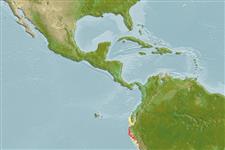分類 / Names
俗名 | 同種異名 | Catalog of Fishes(屬, 種) | ITIS | CoL | WoRMS | Cloffa
Elasmobranchii
板鰓亞綱 (鯊魚與魟魚) (sharks and rays) >
Heterodontiformes (Bullhead and horn sharks)
虎鯊目 (Bullhead and horn sharks) >
Heterodontidae (Bullhead, horn, or Port Jackson sharks)
異齒鮫科 (Bullhead, horn, or Port Jackson sharks)
Etymology: Heterodontus: heteros (Gr.), different; odontos (Gr.), tooth, referring to pointy teeth (for clutching prey) at front of jaws, different than rounded molar-like teeth (for grinding hard-shelled invertebrates) at the back. (See ETYFish); quoyi: In honor of naval surgeon and naturalist Jean René Constant Quoy (1790‒1869), for his friendship, his “tireless zeal and extensive knowledge” (translation) of zoology, and for lessons and advice that have guided Fréminville in his study of science. (See ETYFish).
Environment: milieu / climate zone / depth range / distribution range
生態學
海洋 礁區魚類; 深度上下限 3 - 40 m (Ref. 5227), usually 16 - 30 m (Ref. 54549). 熱帶; 0°S - 10°S, 90°W - 71°W
Eastern Pacific: Peru (including offshore islands) and the Galapagos Islands. There might be another Heterodontus species from Peru which is Heterodontus peruanus, but these two cannot be separated as of this time for lack of materials examined.
東太平洋: 祕魯 (包括離岸島嶼) 與加拉巴哥群島。 可能有 Heterodontus peruanus 的另一個 Heterodontus 種從祕魯, 但是無法區分兩者由於此次缺乏調查標本。
大小 / 重量 / 年齡
Maturity: Lm ? range ? - ? cm
Max length : 107 cm SL 雄魚/尚未辨別雌雄; (Ref. 5227)
Inhabits sand flat and rocky, boulder strewn reef areas, with sand between outcroppings in inshore continental and insular waters. Rests motionless on the bottom. Is docile, non-aggressive and a poor swimmer (Ref. 5227). Nocturnal (Ref. 43278). Feeds on shellfish, crabs, and small invertebrates (Ref. 28023). Oviparous (Ref. 50449). Size at birth (for a newly hatched male) is 17 cm.
棲息於沙地淺灘與岩石的, 卵石礁區, 在近海大陸與海島的水域中有在露出的部分之間的沙子。 在底部上靜止不動。 可馴服又非侵略性與一個游泳能力不佳者是.(參考文獻 5227) 吃貝,螃蟹與小型無脊椎動物。 (參考文獻 28023) 卵生的.(參考文獻 50449) 出生時的大小 (對於一個最近孵化的雄魚) 是 17 公分。
Life cycle and mating behavior
成熟度 | 繁殖 | 產卵場 | 卵 | 孕卵數 | 仔魚
Oviparous, paired eggs are laid. Embryos feed solely on yolk (Ref. 50449). Distinct pairing with embrace (Ref. 205).東太平洋: 祕魯 (包括離岸島嶼) 與加拉巴哥群島。 可能有 Heterodontus peruanus 的另一個 Heterodontus 種從祕魯, 但是無法區分兩者由於此次缺乏調查標本。
Compagno, L.J.V., 1984. FAO Species Catalogue. Vol. 4. Sharks of the world. An annotated and illustrated catalogue of shark species known to date. Part 1 - Hexanchiformes to Lamniformes. FAO Fish. Synop. 125(4/1):1-249. Rome, FAO. (Ref. 247)
人類使用
漁業: 沒有興趣
更多資訊
參考文獻養殖養殖資訊品種遺傳學Electrophoreses遺傳率疾病加工NutrientsMass conversion
合作者照片Stamps, Coins Misc.聲音神經毒速度泳型鰓區Otoliths腦重體重比眼睛色素
工具
特別的報告
下載 XML
網路資源
Estimates based on models
Preferred temperature (Ref.
123201): 17.7 - 23.2, mean 20.5 °C (based on 16 cells).
Phylogenetic diversity index (Ref.
82804): PD
50 = 0.5059 [Uniqueness, from 0.5 = low to 2.0 = high].
Bayesian length-weight: a=0.00380 (0.00166 - 0.00872), b=3.15 (2.95 - 3.35), in cm total length, based on LWR estimates for this (Sub)family-body shape (Ref.
93245).
營養階層 (Ref.
69278): 3.5 ±0.50 se; based on food items.
回復力 (Ref.
120179): 低的, 最小族群倍增時間4.5 - 14 年 (Fec assumed to be <100).
Fishing Vulnerability (Ref.
59153): Very high vulnerability (78 of 100).
Nutrients (Ref.
124155): Calcium = 12.5 [2.4, 47.7] mg/100g; Iron = 0.364 [0.088, 1.020] mg/100g; Protein = 19.2 [17.1, 21.3] %; Omega3 = 0.0756 [, ] g/100g; Selenium = 27.9 [8.7, 80.7] μg/100g; VitaminA = 53.7 [17.4, 155.9] μg/100g; Zinc = 0.969 [0.473, 1.973] mg/100g (wet weight);
